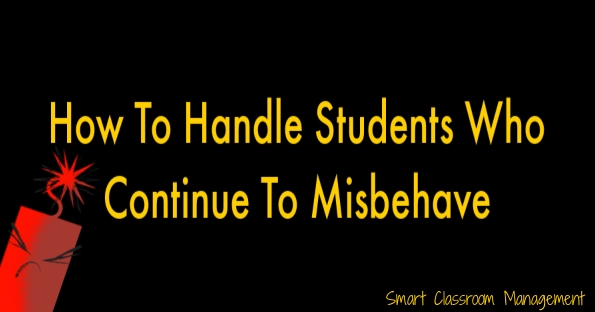
How To Handle Students Who Continue To Misbehave

There are two reasons why students continue to misbehave in the classroom.
The boundary lines are ill-defined.
Enforcement is inconsistent.
Let’s take these one at a time.
By nature, children as young as one and all the way up until adulthood will push and test for boundaries until they find them. If they don’t, if no one tells them no, then they’ll continue to misbehave.
Just the way it is and will always be.
No matter how vehemently you’ve heard it’s about needs and injustice, the underlying reason is immutable. It’s how we’re built.
The longer a child goes without firm boundaries, the worse they behave, the more entitled they become, and the harder it is to turn them around.
This underscores the importance of ensuring that your students know precisely where your boundary lines are. They must be defined exactingly and minutely. There can never, ever be a question as to what is and isn’t okay.
This is best established through modeling and highly detailed teaching of your classroom management plan.
What does each rule mean? What does following them look like? What does breaking them look like? It is through good teaching—like any other subject—that students understand your boundaries.
This is key. It’s only through knowing that students lose the curiosity and deep-seated urge to discover your limits. The reason students seem so intent on misbehaving is because they find comfort and safety in knowing where the line is.
They want you to say no. Though they can’t always put it into words, or even understand their conflicted feelings, students are happy in a well-run and well-behaved classroom is because it means that someone cares.
Knowing the boundaries enables them to let go and enjoy school.
Of course, this means nothing without the second reason students continue to misbehave. You can be as detailed as a watchmaker in establishing your rules, but if you don’t enforce them, then it’s all for naught.
Inconsistency tells students that you don’t mean what you say. It lets them know that you can’t be trusted with anything, academic instruction included.
It also says that you don’t care enough to protect their right to learn and enjoy school without interruption, bullying, being made fun of, and the like. It makes your boundaries as weak and as easy to cross as silly string.
To enforce consequences means that you can’t be afraid. Fear, and its close cousin, playing favorites, is the number one reason teachers look the other way or pretend they didn’t see what they just saw.
They think that somehow students will appreciate them if they give reminders, gentle rebukes, chance after chance, winks, special friendship, or nothing at all.
Of course, this leads to confusion and frustration. It leads to more and more chaos and misbehavior. It leads to the teacher losing their cool, raising their voice, and wondering if they’re cut out for the job.
So, teach your rules like your career and peace of mind depend on it (they do) and do not waver an inch. Follow through like a robot programmed to do so.
And you’ll rid your classroom of continued misbehavior.
PS – To learn how to do all this naturally, and more, please check out my new book Inspire.
Also, if you haven’t done so already, please join us. It’s free! Click here and begin receiving classroom management articles like this one in your email box every week.
